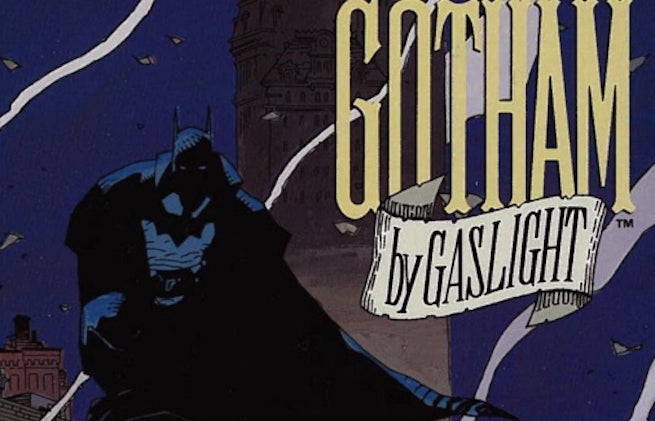From the ashes of DC’s Multiverse came a golden opportunity for DC to reinvent its superhero comics lineup in the mid 1980s. Following the conclusion of Crisis on the Infinite Earths, DC entered an era of great change, developing new origin stories for the likes of Batman, Superman and Wonder Woman, while introducing new and revamped characters like Wally West, Captain Marvel and the Suicide Squad.
Videos by ComicBook.com
Week 3 of DC’s current Convergence event will bring readers back to this tumultuous-yet-celebrated era, complete with some of the creators who helped make Crisis and its aftermath such a hit, like Marv Wolfman and Len Wein. As such, ComicBook.com continues its Convergence Countdown with a retrospective look at DC’s five most significant post-Crisis comics from the 1980s.
5. Gotham Goes Victorian
Gotham by Gaslight wasn’t DC’s first attempt to publish a non-canonical story, but it’s arguably its most influential. Coming on the heels of Crisis, which was supposed to streamline DC’s continuity by eliminating all of the company’s complicated parallel worlds and characters, Gotham by Gaslight was the first installment for a new publishing imprint that would later be known as Elseworlds. While Elseworlds comics were technically parallel worlds, they shared no connections or ties to DC’s main universe.
Written by Brian Augustyn, with art from Mike Mignola and P. Craig Russell, the comic features a Victorian-era Batman fighting the infamous serial killer, Jack the Ripper. It’s a great, self-contained story in its own rite. But more importantly, Gotham by Gaslight established a template for how DC could publish new tales, starring familiar faces, in potentially outrageous situations without the burden of honoring any post-Crisis continuity mandates. If not for Gotham by Gaslight, we may have never gotten such magnificent Elseworld’s stories as The Golden Age, Generations and the biggest of them all, Kingdom Come.
4. Wally’s World
Though Barry Allen heroically died in Crisis, DC’s flagship Silver Age hero, the Flash, lived on in a new series from Mike Baron and Jackson Guice. And rather than reboot or reimagine a new origin for the Scarlet Speedster like DC would do with Batman or Superman post-Crisis, the company took a risk and built its new Flash series around Barry’s former sidekick, Wally West/Kid Flash.
It took some time for readers to warm up to Wally, as Barry was such a beloved character. But brilliant creative runs from William Messner-Loebs and later Mark Waid helped make Wally the definitive Flash for an entire generation of readers – so much so that many fans were upset when DC finally revived Barry during Final Crisis in 2008.
3. A New Batch of Legends
The massive crossover event Legends can be viewed as DC’s post-Crisis coming out party. The main six-issue miniseries, written by John Ostrander and Len Wein and illustrated by John Byrne and Karl Kesel, officially introduced the post-Crisis incarnations of Captain Marvel/Shazam and Wonder Woman. Additionally, Legends debuted Amanda Waller, the head of a brand new “Task Force X” – more colloquially known as the Suicide Squad. In what would become a recurring theme/gag in the covert group’s own series (also written by Ostrander), in Legends #3, a member of the Suicide Squad bites the dust while fighting a Brimstone monster created by the evil Darkseid.
The introduction of the new Suicide Squad alone makes Legends an, *ahem,* legendary comic book event, but the storyline should also be celebrated as a fun and breezy follow-up to the more melodramatic Crisis.
2. Reforging the Man of Steel
It what might have been DC’s greatest creative coup since wooing Jack “King” Kirby over from Marvel in the 1970s, superstar writer/artist John Byrne jumped from the “House of Ideas” to lead the reimagining of the industry’s flagship superhero, Superman.
The Man of Steel miniseries laid out an entirely new status quo for Superman. His powerset was reduced, he was introduced as the sole survivor of his home world, Krypton – thereby eliminating Superboy from the equation – and his adopted parents, Ma and Pa Kent, lived to see their son grow into an adult. Man of Steel also gave new stories for Superman’s first encounters with Lois Lane and Lex Luthor. There’s even an inaugural Superman/Batman throwdown in the series for all of the fans who love to see the two fight.
Further adding to its legacy, Man of Steel would stand as the definitive origin story for Superman for more than 15 years (when Superman: Birthright started to introduce some changes).
1. Year One
Since Crisis ended, nearly every DC superhero has received the “year one” origin reboot treatment. But these are all pale imitators of not only the greatest origin retelling in comic book history, but one of the most iconic Batman stories ever told in Frank Miller and David Mazzuchelli’s “Batman: Year One.”
Dating back to his earliest appearances in the Golden Age, Batman has always been one of the industry’s grittier characters, but Miller and Mazzuchelli redefined what a “Dark Knight” truly was – establishing a template that other Batman creators would follow for years to come. Within the four-part storyline, which ran in Batman #404-407, the creators transformed Gotham City into a dank and despairing city, overrun with mobsters, prostitutes and corrupt cops. And it intrinsically ties Batman to Gotham police detective Jim Gordon, adding more emotional heft to one of comic’s greatest character dynamics.
Following its publication, “Batman: Year One” left its mark on nearly every significant piece of Batman media. It inspired other prequel stories like the Legends of the Dark Knight series and Batman: The Long Halloween. Christopher Nolan even mined a considerable amount of the arc’s content the first part of his Batman film trilogy, Batman Begins. And of course, there’s all of those other “year one” stories that followed. There have been a number of good ones over the year, but when someone says “year one,” you know they’re talking about Batman.
What are your favorite comics of the Post-Crisis era? Sound off in the comments below.














